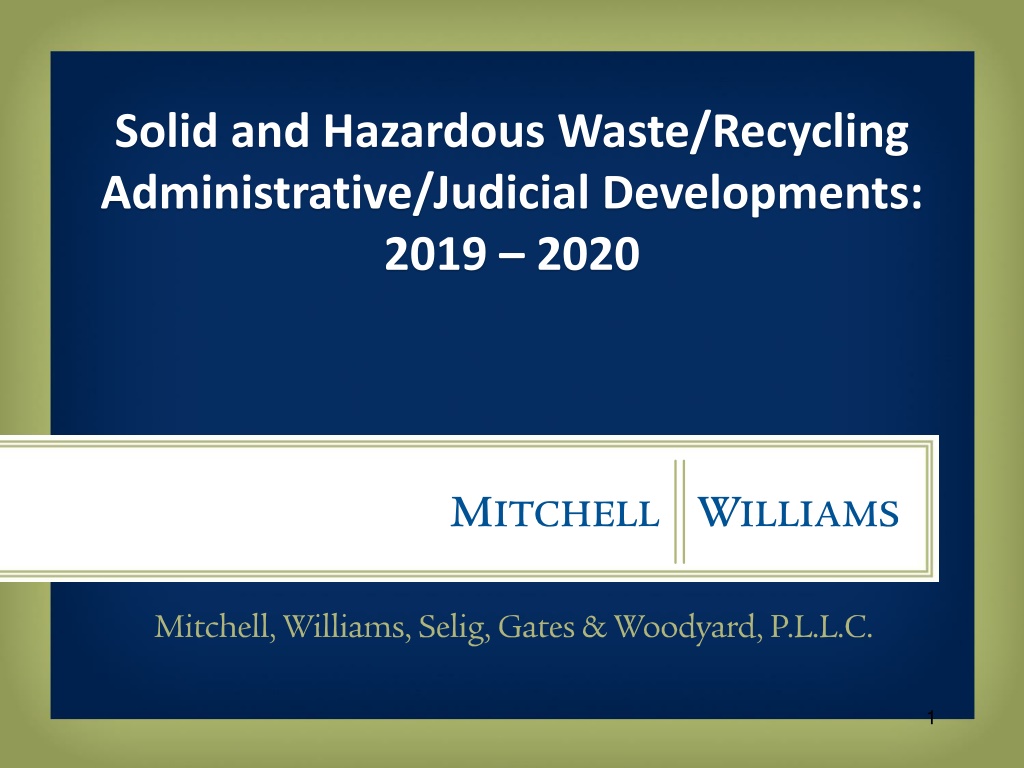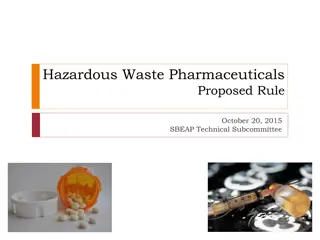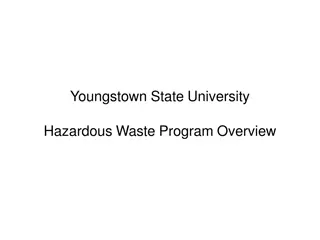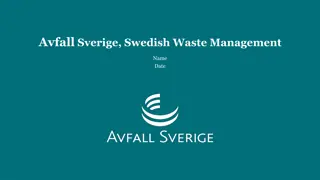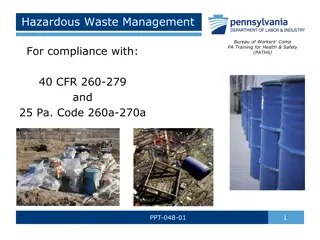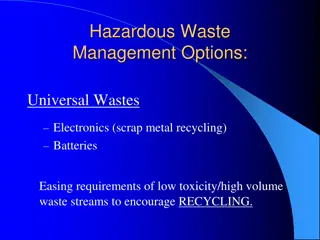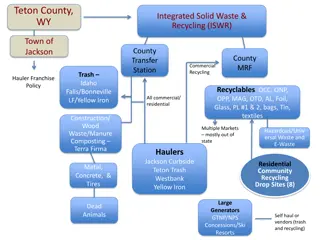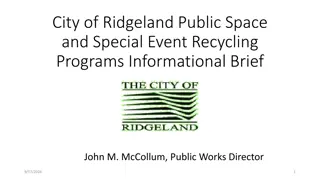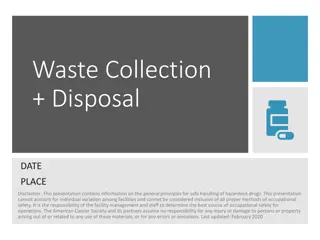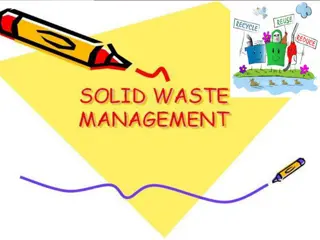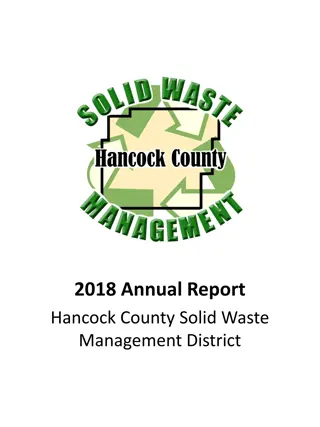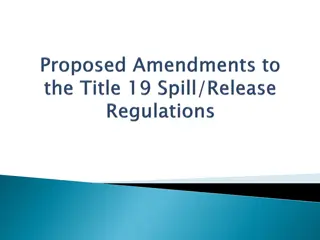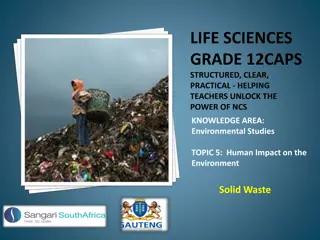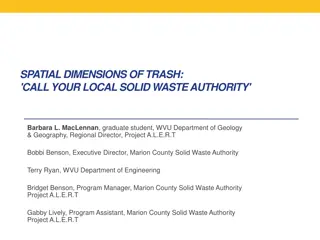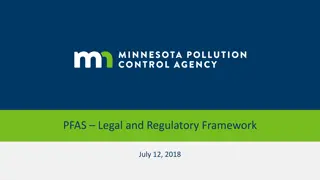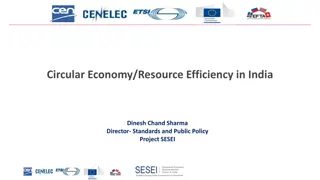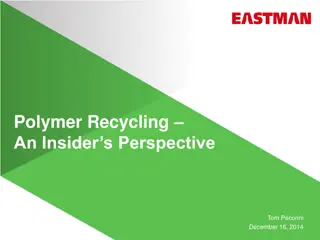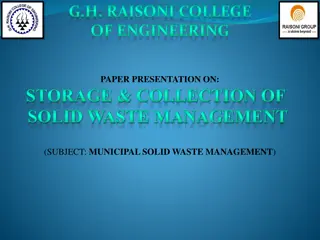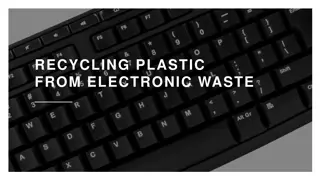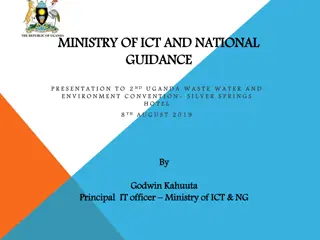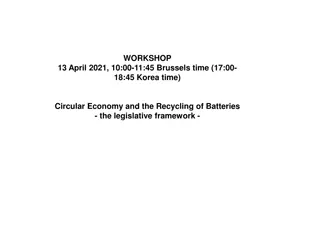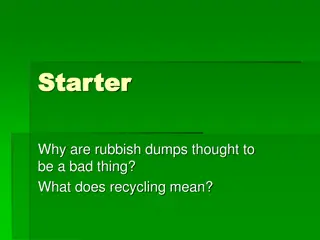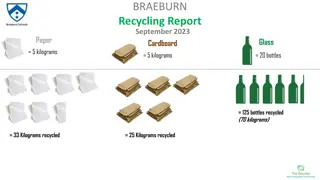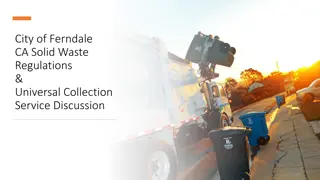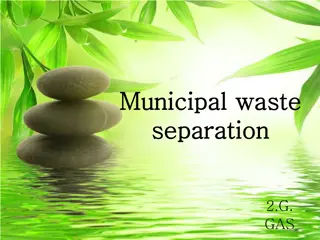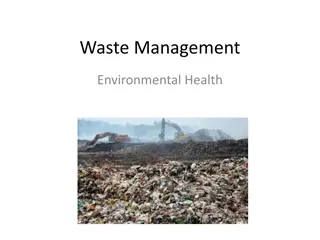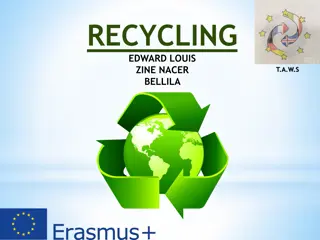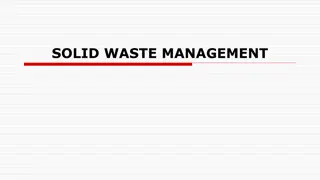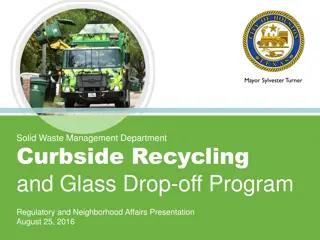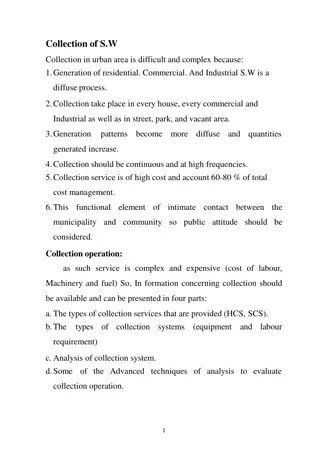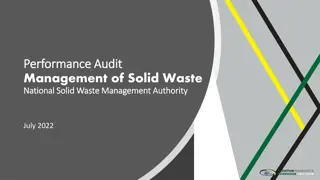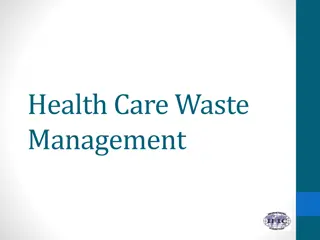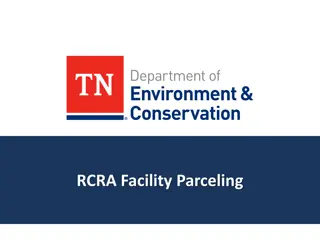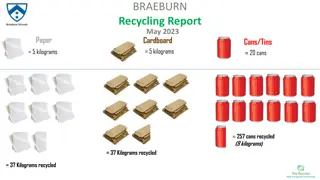Recent Developments in Solid and Hazardous Waste Recycling Regulations
This article discusses various administrative and judicial developments in solid and hazardous waste recycling, focusing on federal and state decisions, litigation, regulations, and policies from the past year. It also delves into the specific waste issues associated with Arkansas Medical Marijuana Rules, including regulations on waste disposal and management. The importance of addressing liability and contractual considerations related to medical marijuana waste generation is highlighted.
Uploaded on Oct 10, 2024 | 0 Views
Download Presentation

Please find below an Image/Link to download the presentation.
The content on the website is provided AS IS for your information and personal use only. It may not be sold, licensed, or shared on other websites without obtaining consent from the author. Download presentation by click this link. If you encounter any issues during the download, it is possible that the publisher has removed the file from their server.
E N D
Presentation Transcript
Solid and Hazardous Waste/Recycling Administrative/Judicial Developments: 2019 2020 1
Walter G. Wright Mitchell, Williams, Selig, Gates & Woodyard 501-688-8839 wwright@mwlaw.com 2
Discussion will address: A variety of federal and state decisions, litigation, rulings, regulations, policies, etc. either directly or indirectly related to solid or hazardous waste (including recycling) that have arisen over the last 12 months or so. 3
Source of information that often addresses issues relevant to solid/hazardous waste and recycling issues: Arkansas Environmental, Energy and Water Law Blog http://www.mitchellwilliamslaw.com/blog Three posts five days a week 4
Arkansas Medical Marijuana Rules/Waste Issues REMINDER A process has been established in which a QualifyingPatient can use medical marijuana. The AMMA does restrict an employer s ability to discriminate against a Qualifying Patient. Safety sensitive positions can exclude Qualifying Patients. ABC regulations require that medical marijuana being disposed of (i.e., waste) be rendered unusable. Medical marijuana wastes and other wastes generated by the cultivation and dispensary processes were identified: Plants (including stalks, roots/soil) and unusable marijuana liquid concentrate or extract Solid concentrate or extract Examples: o Trim and solid plant material used to create an extract o Waste solvent o Laboratory waste o Extract that fails to meet quality testing o Used reactants o Residual pesticides/fertilizers o Cleaning solution o Lighting ballasts 5
Arkansas Medical Marijuana Rules/Waste Issues (Cont.) ABC Regulation 18.1 specifically addresses disposal of marijuana by cultivation facilities and dispensaries. Key provisions of this rule require that medical marijuana is rendered unusable by grinding and incorporating the cannabis plant waste with other ground materials so the resulting mix is at least 50% non-cannabis waste by volume. If so, such materials can be transferred to a solid waste landfill, incinerator, etc., or compostable to such facilities. The need for solid waste management facilities and companies to address from a contractual standpoint medical marijuana waste generated issues was discussed. Topics included: Potential liability for improper disposal of medical marijuana wastes Need to allocate liability in service agreements Generator warranty/certification that waste meets definition of unusable Use of waste profile Provisions for indemnity, rejection, expense for sending back, etc. 6
Brownfields/Arkansas: U.S. EPA Announces Pulaski County and Southwest Arkansas Planning and Development District Grants Federal and State (including Arkansas) incentive provisions, liability exemptions, funding programs, and action/cleanup standards have been utilized for a number of years to attempt to reduce the barriers for reuse or redevelopment of brownfield properties. Goal of the Brownfield Programs is to encourage redevelopment investment in such properties to increase the local tax base, facilitate job growth, utilize existing infrastructure, encourage infield, and take pressure off greenspace. 7
Brownfields/Arkansas: U.S. EPA Announces Pulaski County and Southwest Arkansas Planning and Development District Grants (cont.) Pulaski County and Southwest Arkansas Planning and Development District Awarded $300,000 each The Southwest Arkansas Planning & Development District states that it will target the City of El Dorado s Hillsboro Street Gateway Corridor in regards to the brownfield grant. This area is stated to be located within a Qualified Opportunity Zone. Priority sites are stated to include: A former automotive repair and filling station A former tractor dealership and repair business 8
Commercial Dry Cleaners: Arkansas Department of Environmental Quality and Pulaski County, Arkansas Facility Enter into Elective Site Clean-Up Agreement The Arkansas Department of Environmental Quality and Oak Forest Cleaners and Laundry, Inc. entered into a July 18th Elective Site Clean-Up Agreement . See LIS No. 19-065. The ESCA addresses an Oak Forest commercial dry cleaning and laundry facility in Little Rock, Arkansas, that is stated to have operated since 1986. Agencies may be willing, in some circumstances, to provide blessing (subject to certain caveats) of a site s conditions if they deem contaminants adequately delineated and/or isolated from potential exposure. 9
Commercial Dry Cleaners: Arkansas Department of Environmental Quality and Pulaski County, Arkansas Facility Enter into Elective Site Clean-Up Agreement (cont) The Arkansas ESCA program is an example. The ESCA states that Oak Forest s consultant Trileaf Corporation completed a Phase I Environmental Assessment ( EA ) at the Facility. The EA is stated to have determined that dry cleaning solvents were used on the Facility as follows: Valcene 1986 - 1990 Perchloroethylene 1990 2012 DF-2000 and Solvon K4 dry cleaning solvents Currently 10
Commercial Dry Cleaners: Arkansas Department of Environmental Quality and Pulaski County, Arkansas Facility Enter into Elective Site Clean-Up Agreement (cont) Oak Forest on January 29, 2019, through correspondence to ADEQ, entered into an ESCA to remediate Chemicals of Concern from the soil and groundwater, including volatile organic compounds (VOCs). The ESCA provides sequential tasks for Oak Forest to undertake (delineation, remediation if necessary, institute institutional controls if necessary, etc. Upon approval of the Completion Report, and receipt of deed restrictions if required, ADEQ will issue a No Further Action determination to Oak Forest (which is related to the identified areas of concern and conditioned on specific site uses). 11
Hazardous Waste Enforcement: Arkansas Department of Energy and Environment Division of Environmental Quality and Russellville Engine Camshaft Manufacturer Enter into Consent Administrative Order RCRA Enforcement Continues The CAO provides that Mahle operates a facility ( Facility ) in Russellville, Arkansas that manufactures various types of engine camshafts for large diesel engines from raw steel billets. DEQ is stated to have conducted a Compliance Evaluation Inspection ( CEI ) on March 6, 2019 at the Facility. The CEI allegedly identified the following violations of Regulation No. 23: Failure to make a hazardous waste determination prior to shipment as described in 262.11 Failure to prepare a manifest for hazardous waste prior to transport as described in 262.20(a)(1) 12
Hazardous Waste Enforcement: Arkansas Department of Energy and Environment Division of Environmental Quality and Russellville Engine Camshaft Manufacturer Enter into Consent Administrative Order (cont) Mahle responded in August 7, 2019 correspondence to DEQ that the oily water was evaluated and determined to qualify for the used oil exemption listed in 40 C.F.R. 279, given the TCLP analytical sampling taken on December 14, 2018 reported chromium at 9.25 ppm, below the maximum allowable limit of 10 ppm identified in 40 CFR 279.11. Further, the company is stated to have indicated the oily water was transported by Heritage Crystal Clean to their facility in Little Rock, Arkansas, offloaded into their tank farm, and then transported to their Kilgore, TX facility. At this facility the treatment process is stated to have included the removal and dewatering of the used oil. The used oil was stated to have then been sent to the Crystal Clean re-refinery for recycling into a base lube product. 13
Hazardous Waste Enforcement: Arkansas Department of Energy and Environment Division of Environmental Quality and Russellville Engine Camshaft Manufacturer Enter into Consent Administrative Order (cont) The CAO further provides APC&EC Regulation No. 23 279.11 applies to used oil burned for energy recovery, and any fuel produced from used oil. Mahle states the used oil is being sent for re-refining into a base lubricant product. The used oil is not being burned for energy recovery or being produced as a fuel, therefore, APC&EC Regulation No. 23 Section 279.11 is not applicable. DEQ is stated to have completed a review of the August 7, 2019 response and determined that Mahle did not make a proper waste determination in accordance with Regulation No. 23 Section 262.11. 14
Solid Waste Enforcement: Arkansas Department of Environmental Quality and Independence County, Arkansas School District Enter into Consent Administrative Order The Arkansas Department of Environmental Quality and Southside School District entered into a June 6th Consent Administrative Order addressing alleged violations of Arkansas Pollution Control and Ecology Commission Regulation 22. See LIS No. 19- 053. ADEQ is stated to have observed the presence of multiple piles of construction and demolition ( C&D ) waste including metal, lumber, wires, plastic, roofing material, and carpet. ADEQ is stated to observed certain alleged violations during the inspection which include: Failure to obtain a valid permit from ADEQ to operate a solid waste disposal site Failure to dispose of solid waste at a site or facility with a permit from ADEQ Failure to properly dispose of solid waste pursuant to the rules and regulations and/or in a manner as to not create a public nuisance or public health hazard 15
Tire Enforcement/Request for Injunctive Relief: Arkansas Department of Energy and Environment - Division of Environmental Quality Faulkner County Circuit Court Filing Tires A Continuing Issue The Arkansas Department of Energy and Environment Division of Environmental Quality ( DEQ ) filed a March 19th Verified Complaint and Request for Injunctive Relief ( Complaint ) against Ward Tire and Auto, LLC, ( Ward ) and several individuals. See 23 CV-20-450. The Complaint alleges violations of the: Tire Act, Ark. Code Ann. 8-9-401 et seq. Arkansas Pollution Control and Ecology Commission Regulation 36 Ark. Code Ann. 8-6-201 et seq. Arkansas Pollution Control and Ecology Commission Regulation 22 Most DEQ enforcement actions are pursued through an agency administrative process. Those procedures are incorporated in Arkansas Pollution Control and Ecology Commission Regulation No. 8. However, DEQ has authority to seek judicial remedies through several of the statues implemented. 16
Tire Enforcement/Request for Injunctive Relief: Arkansas Department of Energy and Environment - Division of Environmental Quality Faulkner County Circuit Court Filing (cont) The Arkansas General Assembly enacted legislation a number of years ago whose purpose is to ensure the appropriate management of waste tires. Amendments were made to this legislation in the 91st Arkansas General Assembly. The Complaint s reference to Regulation No. 22 is the Solid Waste Management Code. The Complaint describes property for which DEQ is alleged to have received a complaint regarding tires being dumped. Investigative activities related to alleged tire transporting and solid waste disposal are also described. Whether or not tire rim removal fees were paid to the Arkansas Department of Finance and Administration or accurately reported was also investigated. DEQ seeks remediation of what it describes as a waste tire site and that real property ownership and the solid waste thereon be determined by the Circuit Court and penalties assessed/tires removed. 17
Judicial Enforcement: Arkansas Department of Energy and Environment Pulaski County Circuit Court Action Filed Against Storage Tank Owner/Operator Underground Storage Tanks The Arkansas Department of Energy and Environment, Department of Environmental Quality filed an October 7th Complaint against Routh Wrecker Service, Inc. stating it was seeking injunctive relief and to compel compliance with a previously executed Consent Administrative Order. The CAO is stated to have resolved Routh s alleged violations of environmental laws and regulations regarding its two underground storage tanks located in Little Rock, Arkansas. DEQ and Routh are stated to have entered into the CAO on June 13, 2017, to resolve violations of Ark. Code Ann. 8-7-801 et seq. and Arkansas Pollution Control and Ecology Commission Regulation 12. The Complaint alleges that Routh has not complied with certain provisions of the CAO, which include: Submitting documentation to DEQ indicating that a certified Class A and Class B operator has been designated at the Site Payment of certain UST annual registration fees Payment of a civil penalty 18
Carroll County Solid Waste Authority Request to Become an Arkansas Regional Solid Waste District: Ozark Mountain Solid Waste District Receiver's Notice of Appeal The Receiver (Geoffrey B. Treece) for the Ozark Solid Waste Management District ( District ) filed a Notice of Appeal of the Arkansas Pollution Control and Ecology Commission s ( Commission ) decision to designate the Carroll County Solid Waste Authority as a Carroll County Solid Waste District. The Carroll County Solid Waste Authority previously submitted a Petition to the Commission to designate Carroll County as a Regional Solid Waste District. 19
Carroll County Solid Waste Authority Request to Become an Arkansas Regional Solid Waste District: Ozark Mountain Solid Waste District Receiver's Notice of Appeal (cont) The Receiver petitioned to intervene in the proceedings before the Commission and opposed the Petition. Administrative Law Judge Charles Moulton ( ALJ ) had issued a Recommended Decision granting the Petition. The Commission subsequently upheld the ALJ s Decision granting the Petition. The Receiver has filed a Notice of Appeal in the Circuit Court of Pulaski County, Arkansas (Civil Division) asking that the Commission s Decision be reversed and that the Petition be denied. 20
Trafalgar Stump Dump: Arkansas Pollution Control and Ecology Commission Addresses Bella Vista Property Owners Association, Inc.'s Request for Hearing to Set Aside Consent Administrative Order The Arkansas Pollution Control and Ecology Commission ( Commission ) addressed at its January 24th meeting a request by the Bella Vista Property Owners Association ( POA ) that it conduct an adjudicatory hearing to review the Consent Administrative Order ( CAO ) issued by the Arkansas Department of Energy and Environment Division of Environmental Quality ( DEQ ) in the matter of Thomas Fredericks and Fredericks Construction Company, Inc. (collectively Fredericks ). The site has been further described as real property which is leased to Thomas Fredericks for what is referenced as a stump, brush, rock, concrete, stump and dirt dump. The site suffered an underground fire which was the subject of a DEQ emergency order in 2018. The POA and DEQ subsequently entered into a CAO in which the POA agreed to take responsibility for remediating the site pursuant to the Arkansas Remedial Action Trust Fund Act. 21
Trafalgar Stump Dump: Arkansas Pollution Control and Ecology Commission Addresses Bella Vista Property Owners Association, Inc.'s Request for Hearing to Set Aside Consent Administrative Order (cont) The POA challenged the CAO subsequently entered into between DEQ and Fredericks related to the site. Fredericks responded in subsequent pleadings arguing that nothing in the POA filings identifies any new, material piece of evidence that Director Keogh failed to consider when executing Mr. Frederick s CAO. The Commission, after hearing arguments from counsel for Fredericks, the POA, and DEQ issued Minute Order No. 20- 07. 22
Trafalgar Stump Dump: Arkansas Pollution Control and Ecology Commission Addresses Bella Vista Property Owners Association, Inc.'s Request for Hearing to Set Aside Consent Administrative Order (cont) The Minute Order cites Arkansas Pollution Control and Ecology Commission Regulation 8.406(B) which states: "[a]ny person who comments on a proposed Consent Administrative Order settling an enforcement action may petition the Commission within thirty (30) calendar days of the effective date of the Order to set aside the order and provide an adjudicatory hearing. That person shall file a Request for Hearing with the Commission Secretary. If the evidence presented by the petitioner is material and was not considered in the issuance of the order, and the Commission finds in light of the new evidence that the order is not reasonable and appropriate, it may set aside the order and provide an adjudicatory hearing. If the Commission denies an adjudicatory hearing, it shall give the petitioner notice of its reasons for the denial. The denial of a hearing shall constitute final Commission action." 23
Trafalgar Stump Dump: Arkansas Pollution Control and Ecology Commission Addresses Bella Vista Property Owners Association, Inc.'s Request for Hearing to Set Aside Consent Administrative Order (cont) After hearing oral argument and reviewing the pleadings and exhibits submitted by the parties, the Commission voted to find that Petitioner (POA) had presented material evidence that should have been considered by the DEQ in the issuance of CAO LIS-19-005. As a result, the POA s request for an adjudicatory hearing was granted and Administrative Law Judge Moulton was instructed to hold a hearing to establish a procedural schedule and hold an adjudicatory hearing on the request to set aside the Fredericks CAO. 24
Managing Debris from Declared Disasters: Arkansas Department of Environmental Quality Guidance Document The Arkansas Department of Environmental Quality ( ADEQ ) issued a guidance document titled: Managing Debris from Declared Disasters ( Guidance ) ADEQ states that the document is being issued in response to the June 2019 flood disaster in Arkansas. 25
Addition of Certain Per- and Polyfluoroalkyl Substances/Community Right-to-Know Act: U.S. Environmental Protection Agency Advance Notice of Proposed Rulemaking The United States Environmental Protection Agency issued a pre-publication Advance Notice of Proposed Rulemaking discussing the possibility of adding certain per- and polyfluoroalkyl substances to the Toxics Release Inventory Chemical List under Section 313 of the Emergency Planning and Community Right-to-Know Act and Section 6607 of the Pollution Prevention Act. The Proposal also indicates that EPA is considering establishing reporting thresholds for PFAS chemicals that are lower than the usual statutory thresholds. 26
Addition of Certain Per- and Polyfluoroalkyl Substances/Community Right-to-Know Act: U.S. Environmental Protection Agency Advance Notice of Proposed Rulemaking (cont) PFAS consist of a large group of man-made chemicals. Their properties include resistance to heat, water, and oil. They have been described as persistent in the environment and resist degradation. The compounds have been used in various industrial applications of consumer products such as: Fabrics for furniture Paper packaging for food and other material resistant to water, grease, or stains Firefighting at airfields Utilization in several industrial processes Potential exposure to PFAS includes pathways through drinking water, air, and food. 27
PFOA/PFOS: U.S. Environmental Protection Agency Interim Recommendations The United States Environmental Protection Agency ( EPA ) issued a memorandum on December 19th titled: Interim Recommendations for Addressing Groundwater Contaminated with Perfluorooctanoic Acid and/or Perfluorooctanesulfonate ( Memorandum ) Several states have initiated rulemaking or issued guidance to establish ambient groundwater standards and legislation has been introduced to designate PFAS as a Comprehensive Environmental Compensation and Liability Act hazardous substance. 28
PFOA/PFOS: U.S. Environmental Protection Agency Interim Recommendations (cont.) The December 19th EPA Memorandum provides interim recommendations for addressing groundwater contaminated with perfluorooctanoic acid ( PFOA ) and/or perfluoroctanesulfonic ( PFOS ) at sites being evaluated and addressed under federal cleanup programs such as: Comprehensive Environmental Response, Compensation, and Liability Act Resource Conservation Recovery Act The Memorandum recommends: Using a screening level of 40 parts per trillion (ppt) to determine if PFOA and/or PFOS is present at a site and may warrant further attention. o Screening levels are risk-based values that are used to determine if levels of contamination may warrant further investigation at a site. 29
PFOA/PFOS: U.S. Environmental Protection Agency Interim Recommendations (cont.) Using EPA's PFOA and PFOS Lifetime Drinking Water Health Advisory level of 70 ppt as the preliminary remediation goal (PRG) for contaminated groundwater that is a current or potential source of drinking water, where no state or tribal MCL or other applicable or relevant and appropriate requirements (ARARs) are available or sufficiently protective. o PRGs are generally initial targets for cleanup, which may be adjusted on a site-specific basis as more information becomes available. 30
Perchloreethylene: U.S. EPA Issues Draft Risk Evaluation The United States Environmental Protection Agency ( EPA ) issued a draft risk evaluation ( Draft ) for perchloroethylene ( PERC ). EPA concludes that risks identified in the Draft, including those associated with the chemical s use in dry cleaning, do not require action. PERC is a man-made chemical that can be a liquid or gas. It is also called tetrachloroethylene or tetrachoroethene. The primary use of PERC has been in dry cleaning activities. It has also been used for metal degreasing and general anesthesia. 31
Perchloreethylene: U.S. EPA Issues Draft Risk Evaluation (cont.) The Draft preliminarily found an unreasonable risk to workers, occupational non-users, consumers, bystanders, and the environment from certain uses. The primary health risk stated to have been identified in the Draft was neurological effects from short- and long-term exposure to the chemical. The Draft addresses: Using products safely Public participation, peer review , and next steps Supporting Documents 32
UO19 (Benzene) U220 (Toluene/Delisting Petition for One-Time Amount: April 8th U.S. EPA Federal Register Final Rule RCRA Hazardous Waste Delisting The United States Environmental Protection Agency ( EPA ) published an April 8th Federal Register Notice proposing to finalize a rule delisting a one-time amount up to 20,100 cubic yards of Resource Conservation and Recovery Act ( RCRA ) listed hazardous waste U019 (benzene) and U220 (toluene). The wastes are described as a one-time amount up to 20,100 cubic yards of mixed materials. Further, they are limited to those associated with the closure of hazardous waste management units at three facilities owned and operated by Fire Mountain Farms, Inc., pursuant to closure plans approved by the Washington State Department of Ecology. 33
UO19 (Benzene) U220 (Toluene/Delisting Petition for One-Time Amount: April 8th U.S. EPA Federal Register Final Rule (cont) The closure site is in Lewis County, Washington. The RCRA Subtitle C regulations provide a procedure to exclude or delist a waste in 40 C.F.R. 260.20 and 260.22. The procedure involves the submission of a petition to EPA (or a RCRA authorized state) demonstrating a specific waste from a particular generating facility should not be regulated as hazardous. 34
UO19 (Benzene) U220 (Toluene/Delisting Petition for One-Time Amount: April 8th U.S. EPA Federal Register Final Rule (cont) A petitioner is required to demonstrate that a waste does not meet any of the criteria for a listed waste in 40 C.F.R. 261.1. In addition, the waste cannot exhibit any of the hazardous waste characteristics which include: Ignitability Reactivity Corrosivity Toxicity The granting of the two delisting petitions for the specific identified waste will then exclude this material from the list of hazardous waste so long as the conditions in the delisting are met. 35
Criteria and Process for Objecting to Requests to Import Hazardous Waste to a U.S. Facility: January 8th Resource Conservation and Recovery Act Guidance Document RCRA Guidance The United States Environmental Protection Agency ( EPA ) issued a January 8th Resource Conservation and Recovery Act ( RCRA ) guidance document ( Guidance ) titled: Criteria and Process for Objecting to Requests to Import Hazardous Waste to a U.S. Facility Why is Guidance important (see RCRA Compendium)? The Guidance was authored by Kathleen Salyer, Deputy Director, Office of Resource Conservation and Recovery and transmitted to Land, Chemicals and Redevelopment Division Directors and Enforcement and Compliance Assurance Division Directors. 36
Post-Closure Care at Hazardous Waste Units : U.S. EPA Office of Inspector General Project Notification The United States Environmental Protection Agency ( EPA ) Office of Inspector General ( OIG ) issued a March 23rd Project Notification titled: Post-Closure at Hazardous Waste Units Closed with Waste in Place ( Notification ) The stated objective is to evaluate: . . . whether the EPA s oversight of hazardous waste units closed with waste in place verifies continued protection of human health and the environment. 37
Post-Closure Care at Hazardous Waste Units : U.S. EPA Office of Inspector General Project Notification (cont) The Resource Conservation and Recovery Act ( RCRA ) Subtitle C regulations require certain actions when a hazardous waste management ceases receipt of waste at the end of its active life. The unit must be remediated, monitored and maintained in accordance with the closure and post-closure care requirements are found in the closure and post- closure sections of the RCRA regulations. requirements. These 38
Post-Closure Care at Hazardous Waste Units : U.S. EPA Office of Inspector General Project Notification (cont) Closure of units or facilities can happen in one of two ways: A clean closure (receipt of all waste from the unit and decontaminated to remove all equipment, structures and stranded soil) A closure with waste In place (closure method for facilities or units that cannot meet the clean closure requirements [i.e., all waste and contamination could not be removed]) The closure in place method is being addressed by the Notification. 39
Resource Conservation and Recovery Act/Clean Water Act Citizen Suit Action: Southern Environmental Law Center Alleges Violations by Charleston County, South Carolina, Plastic-Pellet Packager Plastics A New Issue? The Southern Environmental Law Center ( SELC ) filed a March 19th Complaint for Declaratory Injunctive Relief ( Complaint ) against Frontier Logistics, L.P., ( Frontier ) alleging violations of the Resource Conservation and Recovery Act ( RCRA ) and Clean Water Act ( CWA ). The Complaint describes Frontier as providing supply chain management services to the plastics industry. As part of such services, SELC states that Frontier has operated the Union Pier Terminal Facility ( Facility ) in Charleston County, South Carolina, since at least April 2007. The Facility is stated to receive plastic pellets via rail and package them in bulk bags for shipment overseas. 40
Resource Conservation and Recovery Act/Clean Water Act Citizen Suit Action: Southern Environmental Law Center Alleges Violations by Charleston County, South Carolina, Plastic-Pellet Packager (cont) The Complaint alleges that the Facility has released into the environment small pre-production plastic pellets described as nurdles. Charleston Waterkeeper is stated to have collected: . . . over 14,000 plastic pellets from the Cooper River, Charleston Harbor, and waterways, beaches, and parks since the organization began sampling in July of 2019. other Charleston area 41
Resource Conservation and Recovery Act/Clean Water Act Citizen Suit Action: Southern Environmental Law Center Alleges Violations by Charleston County, South Carolina, Plastic-Pellet Packager (cont) It is claimed that pellets remain in Charleston waters and that Frontier is the likely source of the pollution. The alleged violations include: 1. that Frontier has contributed and is contributing to the past or present handling, storage, treatment, transportation, or disposal of solid waste which may present an imminent and substantial endangerment to health or the environment in violation of RCRA, and 2. that Frontier is discharging pollutants into waters of the United States without a National Pollutant Discharge Elimination System permit in violation of the CWA. The RCRA and CWA Federal District Court actions are brought pursuant to the citizen suit provisions of those statutes. Trend? 42
Release Reporting/CERCLA Enforcement: U.S. Environmental Protection Agency and Erie, Pennsylvania Chemical Manufacturing Facility Enter into Consent Agreement Reminder Tight Reporting Deadlines The United States Environmental Protection Agency ( EPA ) and BASF Corporation ( BASF ) entered into a February 13th Consent Agreement ( CA ) addressing alleged violations of the Comprehensive Environmental Response, Compensation and Liability Act ( CERCLA ). See CERC-EPCRA-03-2020-0062. The CA provides that BASF is the owner of a chemical manufacturing facility ( Facility ) in Erie, Pennsylvania. BASF is stated to be in charge of the Facility. Further, it is stated to be classified as a Facility as defined by Section 101(9) of CERCLA. The CA states in part: . . . Beginning at or around 5:50 p.m. on September 20, 2016, and continuing until approximately 1:00 a.m. on September 21, 2016, approximately 10 ,000 gallons of wastewater, classified as a RCRA F005 waste, were discharged from Building 300 when the Maleic Sewer Tank (T-320) overflowed due to a pump malfunction. As a result, 2,000 gallons of wastewater was discharged to the surface of the ground in the gravel lot adjacent to Building 300, and 8,000 gallons flowed to the Building 100 concrete trench, which drains to the site's storm sewer system and ultimately to Motsch Run and Lake Erie (the "Release "). According to EPA' s calculation, 2000 gallons of the wastewater equals approximately 16,680 pounds, and 8,000 gallons equals approximately 66,720 pounds. 43
Release Reporting/CERCLA Enforcement: U.S. Environmental Protection Agency and Erie, Pennsylvania Chemical Manufacturing Facility Enter into Consent Agreement (cont) Section 103 of CERCLA requires facilities to immediately notify the National Response Center of any release of hazardous substance in an amount equal to or greater than the reportable quantity for that substance. In order for a release to be considered reportable under CERCLA, there are three criteria that must be met which include the following: Be into the environment Be equal to or exceed the reportable quantity for a particular substance Occur within a 24-hour period The terms environment and facility are very broadly defined by CERCLA. 44
Release Reporting/CERCLA Enforcement: U.S. Environmental Protection Agency and Erie, Pennsylvania Chemical Manufacturing Facility Enter into Consent Agreement (cont) F005 waste released is stated to be a CERCLA hazardous substance. Further, the CA contends that the Facility released a hazardous substance in a quantity equal to or exceeding a reportable quantity for that hazardous substance, requiring immediate notification to the National Response Center. BASF is stated to have been first aware that the release was occurring at approximately 5:50 p.m. on September 20, 2016. It is stated to have reported the release to the National Response Center at approximately 1:11 p.m. on September 21, 2016. As a result, it is alleged that BASF failed to immediately notify the National Response Center of the release as soon as BASF knew or should have known that a release of hazardous substance had occurred at the Facility in an amount equal to or exceeding the applicable reportable quantity. 45
Solid/Hazardous Waste Criminal Enforcement: 2019/2020 Examples Besides civil enforcement provisions, almost every state (including Arkansas) and federal environmental media program includes potential criminal enforcement penalties. Generally speaking, criminal enforcement is potentially imposed when there is a knowing violation of a statute or regulation. Environmental criminal enforcement more often occurs at the federal level. 46
Solid/Hazardous Waste Criminal Enforcement: 2019/2020 Examples (cont.) Below are a few random examples of federal criminal environmental enforcement from 2019/2020: o Illegal storage of hazardous waste/RCRA Chemist sentenced in Illinois for alleged abandonment of various chemicals at a facility that required hundreds of thousands of dollars to remediate o Illegal dumping of caustic waste/Clean Water Act Washington State drum reconditioner allegedly used a hidden drain to dispose of caustic chemicals (high Ph level) into an adjacent storm sewer 47
Solid/Hazardous Waste Criminal Enforcement: 2019/2020 Examples (cont.) o Illegal hazardous waste storage/RCRA Kansas laboratory found guilty of storing hazardous waste without a license after facility closed and failed to undergo decontamination process o Illegal transportation/RCRA California coatings facility pleads guilty to illegally transporting hazardous waste from its facility without a manifest a decommissioning 48
Solid/Hazardous Waste Criminal Enforcement: 2019/2020 Examples (cont.) o Making a false statement Water system operator in Kansas sentenced for allegedly making a false statement and a report to a state environmental agency which contained falsely represented water samples at a water treatment plant o Illegal storage of hazardous waste/RCRA Company and individual sentenced for allegedly storing hazardous waste in various drums and containers (including a pit dug in the ground in the lower level of a building) to avoid legitimate transportation/disposal 49
Solid Waste/Criminal Enforcement: Louisiana Department of Environmental Quality Announces Arrest of Orleans Parish Disposal Contractor for Alleged Illegal Dumping The Louisiana Department of Environmental Quality issued a September 10th news release stating that an Orleans Parish individual was arrested for allegedly violating environmental laws and criminal trespassing. The Criminal Investigation Division of LDEQ arrested the individual. The charges include: Felony camp of dumping solid waste into waters of the state Two misdemeanor counts of allegedly illegally disposing of solid waste Twelve misdemeanor counts of criminal trespassing 50
